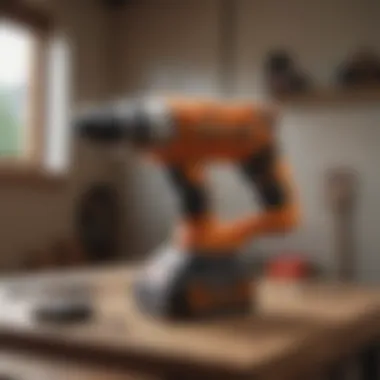Essential Tools for Home Maintenance and Improvement


Intro
Understanding how to maintain and improve your home is an essential skill for any homeowner. Engaging in your own home repairs and upgrades not only creates a sense of accomplishment but also saves money in the long run. This journey can begin with knowing the basic yet essential tools required to effectively tackle common household projects. Having the right tools makes the difference between a hassle-free task and a frustrating experience.
This article will explore the core tools necessary for various home maintenance and improvement tasks. With insights tailored for both novices and seasoned DIYers, we will delve into purposes for each tool, helping you strike a balance between quality, efficiency, and budget.
Home Features
When considering home maintenance and improvement, it is crucial to acknowledge the home's design and structure. Various architectural styles and interior trends can influence how and what tools are necessary for upkeep.
Architectural Styles
Different architectural styles often require specific tools for repairs and enhancements. For example, a Victorian house might necessitate tools that accommodate intricate woodworking, while a modern minimalist home might focus more on functionality and versatility.
- Traditional Homes: Tools like chisels, planes, and hand saws are useful for detailed woodwork and restoration.
- Contemporary Homes: Power tools such as drills and rotary saws help execute clean cuts and detailed installations with precision.
By understanding the architectural style of your home, you can assemble a toolkit that best serves its unique features.
Interior Design Trends
Interior design trends are ever-changing, and so are the tools needed to keep up. For instance, the rise of open spaces can influence your choice of tools, as larger projects might call for more robust equipment.
- Functional Decor: Incorporate tools that support multifunctionality, such as measuring tapes, stud finders, and levels for optimal layout and design.
- Sustainable Practices: Renewable materials are often emphasized in modern design. Tools for quick assembly and disassembly, like adjustable wrenches and hex drivers, make it easier to adapt furniture to a sustainable lifestyle.
Epilogue
Comprehending the essential tools required for home maintenance and improvement stretches beyond merely having the items at hand. It encapsulates a deeper awareness of the home’s structure, design, and existing features. By equipping yourself with the right tools, you can ensure that your home adjustments are efficient, precise, and aligned with contemporary trends in architecture and interior design.
The next sections will further elaborate on the specific tools you should consider for various tasks, fostering a profound understanding of each tool's role in enhancing your living environment.
Prologue to Home Tools
In the realm of home maintenance and improvement, the tools one possesses are not merely accessories but essential instruments that determine the ease and effectiveness of various tasks. Homeowners often face challenges ranging from simple repairs to complex renovations; therefore, having the right tools can lead to significant benefits. With a properly equipped toolkit, it becomes feasible to address unexpected issues promptly, thereby upholding the integrity and value of the home. Additionally, possessing the right tools enables individuals to engage in projects that enhance the livability and aesthetic appeal of their spaces.
Considerations about home tools extend beyond utility. They also encompass safety, efficiency, and cost-effectiveness. Using inaccurate or inadequate tools can result in mishaps, mistakes, and wasted resources. Conversely, investing in high-quality tools pays dividends over time in terms of productivity and durability. Thus, understanding the importance of each tool type is crucial for any homeowner.
Importance of Having the Right Tools
The right tools are foundational for successful home maintenance and improvement. When tackling a repair or a renovation project, using the appropriate tool increases the likelihood of accomplishing the task effectively. For example, using a proper drill for creating holes ensures precision while minimizing damage to the material being worked on. Without the correct equipment, those tasks become arduous and prone to error.
Moreover, the right tools can foster a sense of confidence in one’s DIY abilities. Homeowners who feel prepared with adequate equipment are more inclined to undertake projects, leading to skill enhancement over time. This is especially important for those who wish to increase their competency in home care, as self-reliance in repairs can reduce dependence on contractors and save money long-term.
Overview of Essential Tool Categories
Understanding the various categories of tools is integral to effective home maintenance. Tools generally fall into a few major classifications: hand tools, power tools, and specialized tools. Each category serves distinct functions and supports different types of tasks.
- Hand Tools: These are the backbone of any toolkit. Common hand tools include screwdrivers, hammers, pliers, and wrenches. They require manual effort and finesse to operate, making them suitable for precision tasks.
- Power Tools: These are electric or battery-operated tools that provide greater efficiency and speed. Drills, saws, and sanders make up this category. They are invaluable for larger projects where hand tools would be impractical or time-consuming.
- Specialized Tools: Sometimes, specific tasks need unique instruments. Tools like stud finders or caulking guns fall into this category. They address particular requirements that general hand or power tools cannot satisfy.
Having a good mix of these tool categories ensures that homeowners are prepared for a wide variety of maintenance and improvement activities. Being familiar with each type and its application can ultimately lead to better outcomes in home projects.
"Investing in the right tools is investing in your home’s future."


The following sections will delve deeper into the specific tools required for everyday tasks and highlight best practices for maintenance and care.
Basic Hand Tools
Basic hand tools are the foundation of home maintenance and improvement. They are used in everyday tasks and repairs. Having the right hand tools allows homeowners to conduct repairs efficiently and effectively. Basic tools often do not require a power source, making them accessible for nearly every project. This accessibility is crucial as it allows even novices to engage in DIY tasks with confidence.
Screwdrivers and Their Uses
Screwdrivers are indispensable in any toolbox. They come in two main types: flathead and Phillips. Each type serves distinct functions. Flathead screwdrivers have a single flat blade, ideal for slotted screws. In contrast, Phillips screwdriver has a cross shape that fits into Philips-head screws, providing better grip and torque.
Screwdrivers can be used for a variety of tasks, from assembling furniture to electrical work. Properly using a screwdriver minimizes damage to screws, ensuring they last longer.\
Hammers: Types and Applications
Hammers are essential for driving nails, breaking objects, or fitting parts. Different types of hammers fulfill various functions. The claw hammer is commonly used for driving nails but also features a claw for removing them. The ball-peen hammer is used mainly in metalworking, as its shape can shape metal. Understanding the function of each hammer can improve project outcomes, ensuring tasks are completed with greater ease and precision.
Pliers: Versatile Handheld Tools
Pliers are among the most versatile tools available. They are used for gripping, twisting, and cutting wires or small items. There are various types including needle-nose pliers, which can reach into tight spaces, and wire cutters designed to eliminate excess wire in electrical tasks. The diversity of pliers makes them invaluable in both small repairs and larger projects.
Wrenches: Understanding Different Types
Wrenches are crucial for fastening and loosening nuts and bolts. They come in different styles including adjustable wrenches, which can adapt to various sizes, and socket wrenches, which offer more torque. Using the correct wrench is important to avoid stripping nuts and bolts. Being familiar with how each type works ensures you can tackle a range of mechanical tasks, enhancing your home maintenance capabilities.
Measuring Tools for Precision Work
Accurate measurements are vital in any improvement project. Measuring tape is one of the most common tools used. It provides quick and easy length verification. Level tools ensure surfaces are even, which is crucial for installations like shelves and cabinets. Using precise measuring tools prevents costly mistakes that can occur due to wrong measurements, saving time and resources.
"Having the right basic hand tools is equated with efficiency, reducing time spent on projects while increasing their quality."
In summary, basic hand tools are the initial step in home maintenance. Each tool has specific functions that enhance a homeowner’s ability to perform tasks effectively. Grasping the importance of these tools lays the groundwork for more advanced projects in the future.
Power Tools for Efficiency
Power tools play a pivotal role in home maintenance and improvement. They are designed to enhance efficiency, speed, and precision in a variety of tasks. These tools are usually powered by electricity, battery, or compressed air, making them significantly more powerful than standard hand tools. The advantages include reduced effort, quicker completion of projects, and the ability to tackle larger jobs that might be impossible with manual tools. However, it is crucial to choose the right power tool for specific tasks, as their variation is vast. Misusing them can lead to accidents or sub-par results.
The insights presented here aim to equip homeowners with knowledge about the main types of power tools, including their respective functions and ideal applications.
Drills: Variety and Functionality
Drills are a cornerstone in any home improvement toolkit. They come in various types, including corded and cordless. Cordless drills offer flexibility due to their portability, but they often have limited battery life depending on usage. On the other hand, corded drills tend to provide more consistent power, making them ideal for heavier jobs.
Common types of drills include:
- Regular Drill: Used primarily for drilling holes in various materials like wood, metal, and plastic.
- Hammer Drill: Ideal for drilling into tougher materials like brick or concrete due to its hammering action.
- Impact Drill: Best suited for driving screws with high torque.
Understanding how to select a drill based on the task at hand is essential for achieving efficient results.
Saw Types and Their Uses
Saws are crucial for cutting wood and other materials with precision. Depending on the type, they can serve diverse purposes. The most common saw types include:
- Circular Saw: Known for versatile cutting in various materials, making it a common choice for DIY projects.
- Jigsaw: Excellent for intricate cuts or curves, making it ideal for detailed work.
- Miter Saw: Best for cutting precise angles, specifically in trim jobs.


Selecting the right saw can significantly improve project outcomes in home renovations. Each saw type provides unique capabilities tailored to different tasks, demonstrating the importance of knowing their specifications.
Sanders and Their Applications
Sanders are vital tools used to smooth surfaces and prepare them for finishing. The variations in sanders cater to different applications:
- Orbital Sander: Perfect for smaller jobs or finishing work due to its random sanding pattern, leaving no swirl marks.
- Belt Sander: More aggressive and suitable for removing material quickly from larger surfaces.
- Detail Sander: Designed for reaching tight spaces and contours.
Understanding these applications ensures that users can select the appropriate sander for specific projects, enhancing the overall quality of work.
Impact Drivers versus Drill Drivers
Both impact drivers and drill drivers are used for driving screws, but they operate differently. Understanding their unique functions helps determine which tool fits best for the job:
- Drill Drivers: Provide steady torque for drilling holes and driving screws. They are versatile for various materials but may struggle with larger screws or tougher materials.
- Impact Drivers: Utilize rapid bursts of power, delivering more torque for driving larger screws or fastening heavily into tough surfaces. They often require special bits but can make heavy-duty tasks much easier.
Choosing the right driver for your work can save time and ensure that the job is done properly. Power tool efficiency and effectiveness heavily depend on using the right equipment for each task, underscoring the need for informed choices.
Specialized Tools for Specific Tasks
Specialized tools are essential for performing particular jobs effectively in home maintenance and improvement. While basic and power tools cover a wide range of tasks, specialized devices provide added efficiency and precision. Utilizing these tools can significantly reduce the time needed for tasks and ensure professional-level results. Whether it's hanging artwork, installing shelves, or sealing windows, having the right specialized tool can make all the difference. Here, we will discuss some of these invaluable tools and their specific applications.
Stud Finders for Wall Projects
Stud finders are devices used to locate framing studs behind walls. They are particularly important when hanging heavy items, such as shelves or televisions, where ensuring stability and security is crucial. By using a stud finder, homeowners can avoid damaging walls or compromising the structural integrity of a fixture.
Operating a stud finder is relatively simple. Most models have lights or sounds that indicate when a stud is detected. It is vital to choose the correct stud finder that fits your needs. For example, magnetic stud finders are small and affordable, but electronic stud finders offer more accuracy. Homeowners should consider their frequency of use and the types of walls in their homes to select the ideal tool.
Levels: Ensuring Straight Lines
Levels, such as spirit levels and laser levels, are fundamental when aiming to achieve perfectly straight lines. Whether it's installing cabinets or laying tile, precision is paramount. A slight misalignment can lead to significant issues over time.
A typical spirit level utilizes a liquid-filled vial to indicate whether a surface is horizontal or vertical. In contrast, laser levels project beam lines, providing even more accuracy and visibility. When selecting a level, consider your projects. For large areas, a laser level can be more beneficial, while for small jobs, a spirit level suffices. The investment in a quality level will pay off in visually appealing results.
Utility Knives and Their Versatility
Utility knives are among the most versatile tools found in any toolkit. They are used for cutting various materials, including cardboard, rope, or drywall. The design of these knives often includes adjustable blades, which allow users to extend or retract the blade as needed.
There are multiple types of utility knives available. Some are retractable, providing safety features for when the knife is not in use. Others are fixed-blade models that offer more stability for specific cutting tasks. A sturdy utility knife not only saves time but also enhances precision in cutting jobs. When choosing a utility knife, consider the ease of blade replacement and the overall grip of the handle for optimal control.
Caulking Guns for Sealing Gaps
Caulking guns are essential for sealing gaps and cracks around doors, windows, and other openings. Proper sealing helps improve energy efficiency by reducing air leaks. They come in various types, including manual and electric models, each designed for different kinds of caulk.
To use a caulking gun effectively, it is crucial to cut the tip of the caulk tube at an angle. This helps create an even bead when applying the sealant. The pressure applied through the trigger controls the flow of caulk, enabling a clean application without excess. Homeowners should look for a caulking gun that suits their needs, considering ease of use and comfort during prolonged tasks. A well-sealed home not only improves aesthetics but also prevents potential water damage.
Maintenance and Care of Tools
Proper maintenance and care of tools is crucial for any homeowner focused on home maintenance and improvement. Neglecting tools can lead to inefficient work, increased risk of accidents, and ultimately, costly replacements. When tools are well maintained, they last longer, operate more efficiently and ensure better results during tasks. This section explores the key elements critical to maintaining both hand and power tools effectively.
Cleaning and Storing Tools Properly


Cleaning tools after use is essential to preventing rust, debris buildup, and overall deterioration. Dirty tools can lead to unsatisfactory work quality. Here are some tips for cleaning:
- Manual Cleaning: For hand tools, a simple wipe with a damp cloth can remove dust or sap. If there are stubborn residues, using a mild detergent or a specialized cleaner can be effective.
- Power Tools: Carefully clean surfaces and air vents to avoid overheating. Ensure that components are free from debris, especially around blades or drills.
- Drying: Always dry tools thoroughly after cleaning, as moisture can cause rust.
In addition to cleaning, how tools are stored plays a big role in their lifespan. Storing tools properly can prevent damage:
- Dry Environment: Store tools in a dry place to prevent corrosion. A tool chest or cabinet works best.
- Organization: Use pegboards or magnetic strips for easy access and clear visibility. This prevents tools from getting lost or damaged by being jumbled together.
- Safety Considerations: Ensure sharp or dangerous tools are stored where children cannot reach.
Proper cleaning and storage habits not only enhance the longevity of tools but also promote safety and efficiency in projects.
Maintaining Power Tools: Best Practices
Power tools require specific care due to their mechanical and electrical components. Failing to maintain them can result in malfunction or safety hazards. Here are some best practices:
- Regular Inspections: Frequently check for any signs of wear and tear. Look for cracks, frayed wires, or unusual noises when in use.
- Lubrication: Most power tools require lubrication at specified intervals. Refer to the manufacturer’s guidelines to know when and what kind of lubricant to use.
- Battery Care: For cordless tools, ensuring the batteries are charged properly is vital. Store them in a place that is neither too hot nor too cold. Avoid leaving them on the charger for extended periods beyond their charging cycle.
- Calibration: Some power tools like drills require calibration for precise work. Ensure they are calibrated according to manufacturer instructions to maintain accuracy.
Implementing these practices improves the functionality and reliability of power tools. Adequate maintenance also can help avert unforeseen malfunctions during projects, maximizing productivity and safety.
Safety Considerations When Using Tools
Safety is paramount when engaging with tools. Whether one is tackling home repairs or improvement projects, understanding how to use tools safely is essential. Improper use could lead to injuries ranging from minor cuts to severe accidents. This section highlights the critical elements of safety that every homeowner should embrace.
Personal Protective Equipment
Personal Protective Equipment, commonly known as PPE, serves as the first line of defense against potential hazards. It comprises various items designed to protect the user. Key components of PPE include:
- Safety Goggles: These protect the eyes from flying debris and chemical splashes.
- Gloves: Robust gloves shield the hands from cuts, abrasions, and chemical exposure.
- Hearing Protection: Earplugs or earmuffs reduce exposure to harmful noise levels from power tools.
- Dust Masks or Respirators: These help filter respiratory irritants when woodworking or working with chemicals.
By wearing appropriate PPE, individuals create a buffer against injuries, emphasizing preparedness for the tasks at hand.
Understanding Hazardous Situations
A crucial part of tool safety is recognizing hazardous situations. Certain scenarios can present unforeseen risks. Here are some common hazards to consider:
- Electrical Risks: Tools that operate on electricity can pose shocks. Always inspect cords and connections before use.
- Tripping Hazards: Leaving tools and materials scattered can lead to falls. Maintain a tidy workspace.
- Improper Tool Use: Using a tool for a purpose it wasn’t designed for can lead to accidents. Familiarize oneself with each tool’s intended use.
"A safe workspace is not merely a precaution; it is essential for productive work."
By being aware of these factors, individuals can make informed decisions that enhance safety during home maintenance projects. Addressing potential hazards is not just about compliance; it’s about safeguarding oneself and others in the environment.
Culmination: A Well-Equipped Homeowner
Home maintenance and improvement require not only the right tools but also a strategic approach to using those tools effectively. A well-equipped homeowner can navigate various challenges ranging from minor repairs to major renovations. It is essential to understand that investing in quality tools and developing skills around their use leads to improved efficiency and confidence in tackling projects.
Reflecting on Tool Management
Managing your tools comprises several aspects—organization, upkeep, and selection. A proper tool management system allows for easy access and inventory control, ensuring that tools are readily available when needed. Consider establishing a designated space, like a workshop or tool shed, to store your equipment.
Organizing your tools not only saves time but also prevents damage or loss. For instance, using pegboards or toolboxes helps to categorize items, allowing for quick identification. Regular maintenance, like cleaning and sharpening, keeps tools in optimal condition. Adopting a rotation practice for frequently used items can also streamline your workflow and eliminate clutter. Additionally, keeping a checklist for tools that need replacement helps maintain readiness.
The Value of Skills Development
A well-equipped homeowner should also prioritize skills development. Understanding how to efficiently use various tools and techniques can profoundly impact the quality of work and the satisfaction derived from it. Many resources, such as online tutorials and local workshops, offer hands-on experience and training on a wide range of tasks.
By developing practical skills, homeowners increase their ability to complete renovation projects efficiently and safely. These skills foster independence, reducing reliance on contractors for minor tasks and repairs. Furthermore, as your skills improve, you might discover the joy in creating and repairing, giving more enjoyment to the home improvement process.
Investing in both tools and skills ensures that homeowners are not only prepared for immediate projects but also poised for future challenges in home maintenance. This dual investment empowers you to approach home improvement with assurance and know-how.
"The investment in tools and skills is an investment in your home and, ultimately, in yourself."















